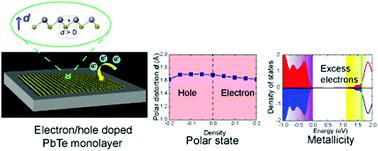当前位置:
X-MOL 学术
›
Nanoscale Horiz.
›
论文详情
Our official English website, www.x-mol.net, welcomes your feedback! (Note: you will need to create a separate account there.)
Two-dimensional polar metal of a PbTe monolayer by electrostatic doping.
Nanoscale Horizons ( IF 9.7 ) Pub Date : 2020-08-15 , DOI: 10.1039/d0nh00188k Tao Xu 1 , Jingtong Zhang , Yuquan Zhu , Jie Wang , Takahiro Shimada , Takayuki Kitamura , Tong-Yi Zhang
Nanoscale Horizons ( IF 9.7 ) Pub Date : 2020-08-15 , DOI: 10.1039/d0nh00188k Tao Xu 1 , Jingtong Zhang , Yuquan Zhu , Jie Wang , Takahiro Shimada , Takayuki Kitamura , Tong-Yi Zhang
Affiliation

|
Polar metals characterized by the simultaneous coexistence of a polar structure and metallicity have been a long-sought goal due to the promise of novel electronic devices. Developing such materials at low dimensions remains challenging since both conducting electrons and reduced dimensions are supposed to quench the polar state. Here, based on first-principles calculations, we report the discovery of a non-centrosymmetric polar structure in two-dimensional (2D) metallic materials with electrostatic doping, even though ferroelectricity is unconventional at the atomic scale. We revealed that the PbTe monolayer is intrinsically ferroelectric with pronounced out-of-plane electric polarization originating from its non-centrosymmetric buckled structure. Moreover, the polar distortions can be preserved with carrier doping in the monolayer, which further enables the doped PbTe monolayer to act as a 2D polar metal. With an effective Hamiltonian extracted from the parametrized energy space, we found that the special elastic-polar mode interaction is of great importance for the existence of robust polar instability (i.e., soft phonon mode associated with polar distortion) in the doped system. The application of this doping strategy is not specific to the present crystal, but is rather general to other 2D ferroelectrics to bring about the fascinating non-centrosymmetric metallic state. Our findings thus change the conventional knowledge in 2D materials and will facilitate the development of multifunctional materials in low dimensions.
中文翻译:

通过静电掺杂PbTe单层的二维极性金属。
由于新型电子设备的前景,以极性结构和金属性同时共存为特征的极性金属已成为人们长期以来追求的目标。以低尺寸开发这种材料仍然具有挑战性,因为导电电子和减小尺寸的电子都被认为可以淬灭极性。在这里,基于第一性原理的计算,我们报告了在带有静电掺杂的二维(2D)金属材料中发现非中心对称极性结构的过程,即使铁电在原子尺度上是非常规的。我们揭示了PbTe单层本质上是铁电体,其非中心对称的弯曲结构引起了明显的面外极化。此外,可以通过在单层中掺杂载流子来保持极性畸变,这进一步使掺杂的PbTe单层能够充当2D极性金属。从参数化的能量空间中提取出有效的哈密顿量,我们发现特殊的弹性-极性模式相互作用对于存在稳健的极性不稳定性非常重要(即在掺杂系统中与极性失真相关的软声子模式。这种掺杂策略的应用并非特定于本发明的晶体,而是普遍适用于其他2D铁电体,以产生引人入胜的非中心对称金属态。因此,我们的发现改变了2D材料的常规知识,并将有助于开发低尺寸的多功能材料。
更新日期:2020-09-28
中文翻译:

通过静电掺杂PbTe单层的二维极性金属。
由于新型电子设备的前景,以极性结构和金属性同时共存为特征的极性金属已成为人们长期以来追求的目标。以低尺寸开发这种材料仍然具有挑战性,因为导电电子和减小尺寸的电子都被认为可以淬灭极性。在这里,基于第一性原理的计算,我们报告了在带有静电掺杂的二维(2D)金属材料中发现非中心对称极性结构的过程,即使铁电在原子尺度上是非常规的。我们揭示了PbTe单层本质上是铁电体,其非中心对称的弯曲结构引起了明显的面外极化。此外,可以通过在单层中掺杂载流子来保持极性畸变,这进一步使掺杂的PbTe单层能够充当2D极性金属。从参数化的能量空间中提取出有效的哈密顿量,我们发现特殊的弹性-极性模式相互作用对于存在稳健的极性不稳定性非常重要(即在掺杂系统中与极性失真相关的软声子模式。这种掺杂策略的应用并非特定于本发明的晶体,而是普遍适用于其他2D铁电体,以产生引人入胜的非中心对称金属态。因此,我们的发现改变了2D材料的常规知识,并将有助于开发低尺寸的多功能材料。


























 京公网安备 11010802027423号
京公网安备 11010802027423号